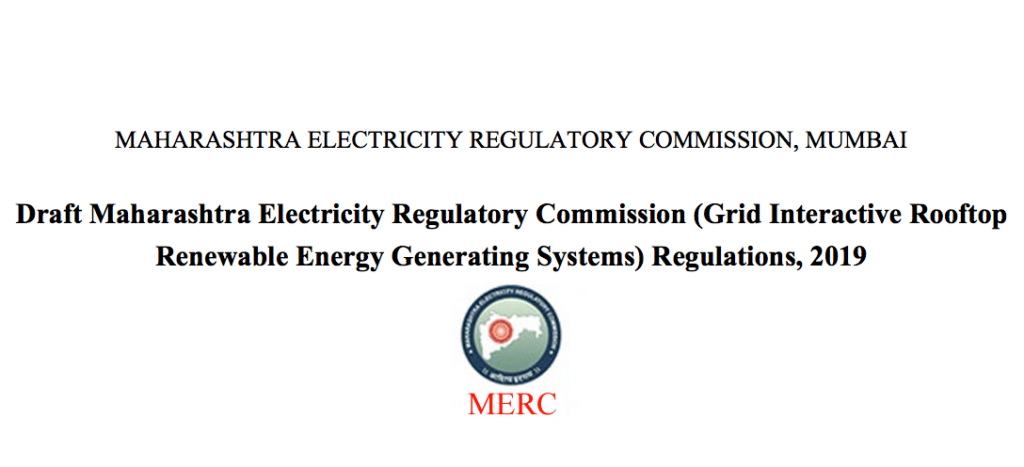Maharashtra Electricity Regulatory Commission (MERC) has come up with a new draft regulation on Grid Interactive Rooftop Renewable Energy Generating Systems. Among other things, the draft proposes to replace the net-metering system with gross metering or Net-billing mechanism.
What is Net-Billing Mechanism ?
Under the net billing system, the energy generated by a rooftop solar system will be sold to the distribution companies (DISCOM) at an approved grid tariff. However, the same consumers would buy it at retail tariff.
Difference between Net-Metering & Net-Billing Mechanism ?
For explanation sake, let us assume that a consumer has installed a grid-interactive rooftop solar power plant & in billing cycle (1 month usually), he/she imports 1000 Units from grid & exports 200 units to the grid.
Under the net-metering mechanism, total units consumed (billable units) are 1000- 200 = 800 Units. Let’s say retail tariff of grid is 8 Rupees/Unit. Then in this case, the energy charge of consumer is 800*8 = 6400 Rupees.
Now, under new mechanism, let assume grid feed in tariff is declared as 4 Rupees/Unit. And the consumer does same as before, imports 1000 units & exports 200 Units. Under the Net- Billing system, the bill of consumer is calculated as follows:
- Import Bill > 1000*8 = 8000
- Export Deduction> 200*4 = 800
- Energy Charge = 8000 – 800 = 7200 (Net Billing)
As one can observe, the savings benefit of the solar power reduces and the bill of the consumers would increase. This in turn, would reduce the incentive for consumer to go for cleaner, greener Solar Power.
All categories other than the residential category may set up the renewable energy generating system only under the net billing arrangement.
Order
Who will not be affected by this probable change ?
- Residential consumers
- Consumers with continuous usage i.e. consumers whose energy consumption was/is continuous and were not/negligible exporting solar units
Who will be affected most ?
- Commercial / Industrial consumers that were exporting power during day and importing at night or one’s who were exporting power during certain days and importing on other days.
According to information, Maharashtra has 22,604 HT consumers, of which only 1371 operate under the net metering policy. The state has massive potential to encourage rooftop solar projects but if commercial and industrial units do not see a financial benefit from setting up their own generation units, they will instead choose to continue drawing power from the grid. This will derail the growth of solar power in Maharashtra.
It is important to note that rooftop solar projects have clear benefits over other forms of power generation, in terms of air pollution, land use, and transmission losses.
Other Salient Features of the Order:
- The capacity limit of 1 MW shall not apply under Net-Billing Arrangement.
- The minimum size of the renewable energy generating system under net billing will be 1 kW.
- Except residential category, all others will have to set up the renewable energy generating system only under the net billing arrangement.
- Net Metering Arrangement or Net Billing Arrangement, as the case may be, shall be permitted by the Distribution Licensee on a non-discriminatory and Distribution Transformer-wise or feeder wise ‘first come, first serve’ basis to Eligible Consumers.
- The size of Renewable Energy Generating System to be connected at the Eligible Consumer’s premises shall not exceed the Sanctioned load (in kW) or the Contract Demand (in kVA) of the Consumer, as applicable.
- The cumulative capacity of all Renewable Energy Generating Systems under Net Metering Arrangements and/or Net Billing Arrangements connected to a particular Distribution Transformer/feeder of the Licensee shall be allowed up to 40% of its rated capacity. Provided that the Distribution Licensee shall allow Net Metering and/or Net Billing connectivity exceeding 40% of such rated capacity, unless any adverse impact has been assessed based on a detailed load study carried out by it.
Reference
- Draft Maharashtra Electricity Regulatory Commission (Grid Interactive Rooftop Renewable Energy Generating Systems) Regulations, 2019 – Download PDF

